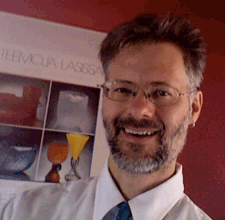Pilgrim Reindeer in Pisa, 1348
a free multimedia novel by
Thomas A. DuBois, University of Wisconsin-Madison
 |
Pilgrim Reindeer in Pisa, 1348 a free multimedia novel by Thomas A. DuBois, University of Wisconsin-Madison |
|
|
|
Part II. The Hansa Lands and France. 25. Simon the Jew [October 15, 1347]
In this chapter, as in the previous one, I wanted to explore the differing notions of work and human relations that would distinguish a man from a hunter-gatherer society from a fourteenth-century merchant. It was one of the realities of the fourteenth century that in the far north of Europe, Sámi people carried on traditions of subsistence and trade alliances while farther south elaborate market-based economies were rapidly developing. As we shall see in coming chapters, these economic developments brought with them political and social changes as well and they are at the heart of what transforms medieval Europe into the Western societies we take for granted today. So Bávlos needs to notice and think about these differences, and Simon served as an ideal figure to help instruct him on all matters regarding medieval trade.
I also wanted to let Bávlos get to know a Jewish person and learn about Judaism. Bávlos notes features of Jewish tradition that he recognizes from his own culture: the tradition of living in tents, for instance (a present reality for Bávlos, an ancient past for Simon). And the Jewish God reminds Bávlos of the Iesh he has come to know: a deity who refers to himself as "Self" and who calls on his followers to uproot themselves and wander forth at his bidding, often after a name change. Despite the fact that Bávlos views Jewish culture very positively, the chapter makes it clear that Christians do not regard Judaism favorably in this era. Simon must wear a badge to inform all who see him of his religious alterity, and he has difficulty finding a way of travelling from one city to another. These realities are mentioned only in passing in the text, but they were real hardships in the fourteenth century and only part of a host of measures that combined to make life difficult and unpleasant for Jews living in Hanseatic cities during the era.